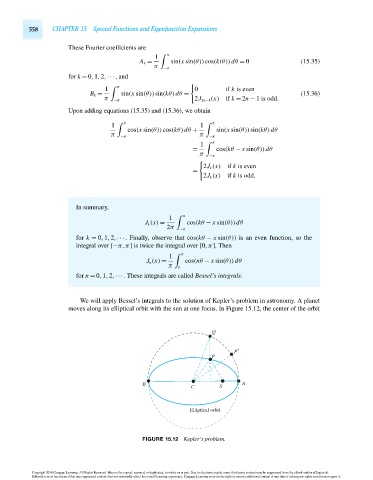Page 578 - Advanced_Engineering_Mathematics o'neil
P. 578
558 CHAPTER 15 Special Functions and Eigenfunction Expansions
These Fourier coefficients are
1 π
A k = sin(x sin(θ))cos(k(θ))dθ = 0 (15.35)
π −π
for k = 0,1,2,···, and
1 π 0 if k is even
B k = sin(x sin(θ))sin(kθ)dθ = (15.36)
π −π 2J 2n−1 (x) if k = 2n − 1 is odd.
Upon adding equations (15.35) and (15.36), we obtain
1 π 1 π
cos(x sin(θ))cos(kθ)dθ + sin(x sin(θ))sin(kθ)dθ
π −π π −π
1 π
= cos(kθ − x sin(θ))dθ
π −π
2J k (x) if k is even
=
2J k (x) if k is odd.
In summary,
1 π
J k (x) = cos(kθ − x sin(θ))dθ
2π −π
for k = 0,1,2,···. Finally, observe that cos(kθ − x sin(θ)) is an even function, so the
integral over [−π,π] is twice the integral over [0,π]. Then
1 π
J n (x) = cos(nθ − x sin(θ))dθ
π 0
for n = 0,1,2,···. These integrals are called Bessel’s integrals.
We will apply Bessel’s integrals to the solution of Kepler’s problem in astronomy. A planet
moves along its elliptical orbit with the sun at one focus. In Figure 15.12, the center of the orbit
Q
P *
P
B A
C S
Elliptical orbit
FIGURE 15.12 Kepler’s problem.
Copyright 2010 Cengage Learning. All Rights Reserved. May not be copied, scanned, or duplicated, in whole or in part. Due to electronic rights, some third party content may be suppressed from the eBook and/or eChapter(s).
Editorial review has deemed that any suppressed content does not materially affect the overall learning experience. Cengage Learning reserves the right to remove additional content at any time if subsequent rights restrictions require it.
October 14, 2010 15:20 THM/NEIL Page-558 27410_15_ch15_p505-562

